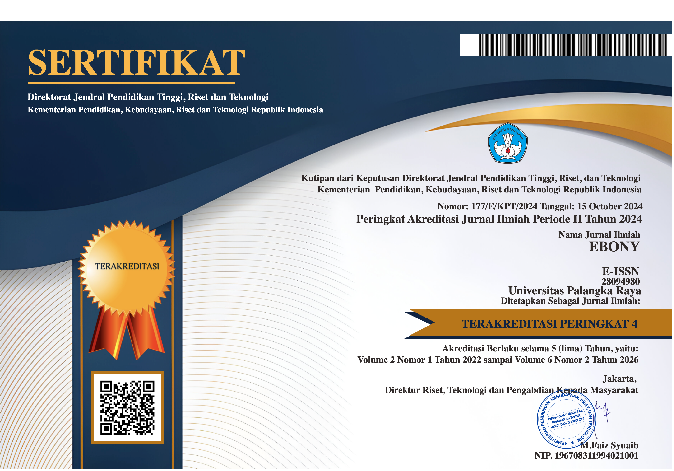The Use of English Outside the Classroom by Students of the English Education Study Program
DOI:
https://doi.org/10.37304/ebony.v4i1.12394Keywords:
speaking problems, English use, out of classroomAbstract
English is a widely used language in various countries. The purpose of this study is to determine whether students use English beyond the classroom and to identify reasons for not doing so, with a focus on speaking. The study utilizes a quantitative research method, involving descriptive statistical data analysis, with students from the English 2023 program as subjects. Data was collected through a Likert scale with 10 statements and reasons for not using English outside the classroom. Results indicate that 71 students used English outside of class, with lack of participation being the primary reason for those who did not. It is important for students to use English beyond the classroom to improve their speaking skills and vocabulary.
Downloads
References
Abdullah, D., Jannah, M., Aiman, U., Hasda, S., Fadilla, Z., Taqwin, N. (2022). Metodologi Penelitian Kuantitatif. Alfabeta.
Anum, A. (2018). Interaksi mahasiswa dalam meningkatkan kemampuan berbicara bahasa Inggris (studi pada mahasiswa fakultas ilmu sosial dan ilmupolitik). Reswara: Jurnal Pengabdian Kepada Masyarakat.
Arianti, A., &Numaningsih, V. U. (2020). Habit Formulation Berkomunikasi Bahasa Inggris pada Mahasiswa Program Studi Pendidikan Bahasa Inggris. Prosiding Seminar Nasional.
Chaniago, A. (2019). Pengaruh motivasi kerja dan displin kerja terhadap produktivitas kerja karyawan pada PT Capella dinamik Nusantara.
Hakim, M. A. (2019). Strategi Pengajaran Speaking Bagi Para Pembelajar Bahasa Inggris Berkarakteristik Introverts, Jurnal Pendidikan.
Haque, A. (2017). Use of English outside the classroom: Investigating learner attitudes. Journal of the Department of English.
Ipek, O. F., & Mutlu, H. T. (2021). English Outside The Classroom In The Age Of Technology: A Concurrent Triangulation Mixed Method Study. International Online Journal of Education and Teaching.
Joshua, T. (2006). Introduction To Descriptive Statistics, The University Of South Carolina. Department of statistics.
Linda, D, A., G., W., & Wathen, M. A. (2019). Basic statistics for business & Economic. New York: McGraw-Hit Education.
Luhita, D. R. (2018). An analysis of students' challenges in speaking English inside and outside of class.
Mohamed, D. H. (2022). Obstacles Faced by Students in Speaking English Language. IJRDO-Journal of Educational Research.
Mundir, D. H. (2013). Metode Penelitian Kualitatif dan Kuantitatif. STAIN Jember Press.
Noermanzah. (2019). Bahasa sebagai Alat Komunikasi, Citra Pikiran, dan Kepribadian. Prosiding Seminar Nasional Bulan Bahasa (Semiba).
Peck, R., Olsen, C., Devore, J. (2008). Introduction to Statistics and Data Analysis. USA: Thomson Higher Education
Pratiwi, H. N. (2019). Pengaruh Kompetensi dan Beban Kerja Terhadap Kinerja Pegawai pada Dinas Komunikasi dan Informatika Provinsi Jawa Barat. Institusional repositories & scientific journal.
Putra, R.D. (2019). Speaking Barriers in Learners of English as a Foreign Language at the Fourth Semester in Sekolah Tinggi Keguruan Dan Ilmu Pendidikan Muhammadiyah Kotabumi Academic Year 2018/2019. Online Repository Universitas Muhammadiyah Kotabumi
Rahayu, N. (2015). An Analysis of Students' Problems In Speaking English Daily Language Programat Husnul Khotimah Islamic Boarding School.
Sargsyan, M., & Kurghinyan, A. (2016). The use of English language outside the classroom. Journal of Language and Cultural Education.
Sukatno. (2022). Improving Learning Mastering Vocabulary Through Super Camp XII of IPA SMAN 1 Girimarto Students. Jurnal JARLITBANG Pendidikan.
Tayl, E. N. (2013). The Use of English the Classroom by Students of SMP Kristen Lentera. Universitas Kristen Satya Wacana.
Downloads
Published
How to Cite
Issue
Section
License
Copyright (c) 2024 Libertina Lase

This work is licensed under a Creative Commons Attribution 4.0 International License.











